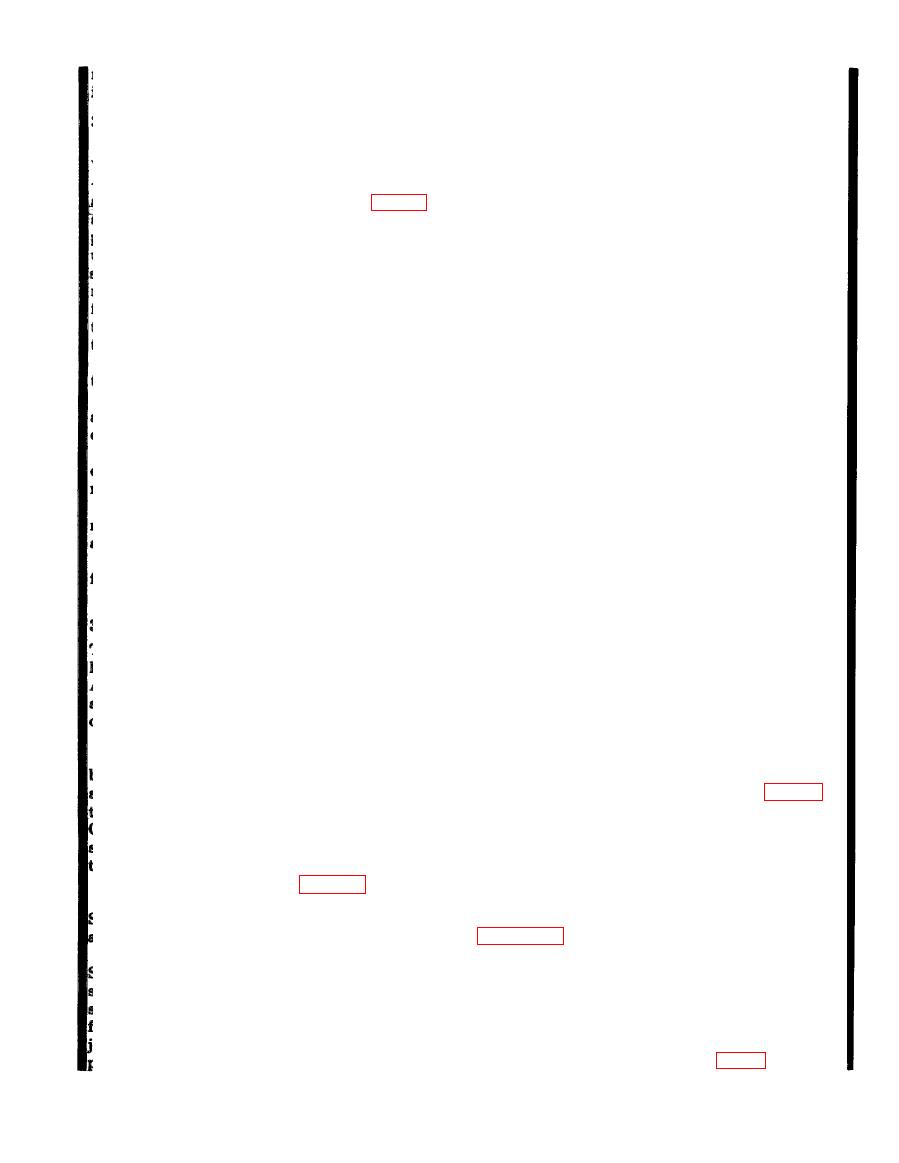 |
|||
|
|
|||
|
Page Title:
Adjustment of Automatic Time-Print Switch |
|
||
| ||||||||||
|
|  TM 11-6660-204-25
record at 95. Let the recorder trace a 1/4-inch line to
the setting of the OUTPUT LEVEL control during
insure proper setting of the control.
the following procedures.
b. Linearity Calibration Test.
(1) Set the frequency standard CYCLES control
Switch
to 190. Adjust the radiosonde recorder REF. AD-
JUST control as necessary to cause the recorder to
When Radiosonde Recorder AN/TMQ-5A, -513, or
print at 95 recorder divisions. Allow sufficient time
-5C are used with Rawin Set AN/GMD-1(*), the
for the recorder to print a trace approximately
action of automatic time-print switch S504 (fig. 3- 14)
3/8-inch in length. (Do not make any additional
should cause the control recorder to produce a time
changes in the REF. ADJUST setting for the remain-
print each time the radiosonde recorder penis moved
der of this test).
up-scale through the range of 89-91 recorder divi-
(2) Change the output of the frequency standard
sions. If automatic time printing occurs when the
to 180 hertz (cycles). Again allow the recorder to
recorder pen is at any other position, perform the
produce a 3/8-inch trace.
following adjustment procedures: (The automatic
time-print switch is not included in earlier models of
(3) Using all frequencies (including zero) availa-
ble from the frequency standard, repeat step (2) in
the radiosonde recorder.)
descending order and then in ascending order.
a. Turn the recorder power switch to the OFF posi-
(4) Place the frequency standard POWER
tion.
switch to OFF. Place the recorder POWER switch to
b. Manually turn the balancing motor split-gear
OFF or STANDBY as desired.
assembly to position the pointer at the 90-division
c. Construction of Linearity Correction Graph.
chart line on the scale.
(1) Use the manual chart advance knob to ad-
c. Loosen the locking screw securing the bracket
vance the portion of the chart containing the record-
on which the time print only microswitch (S504) is
ings and tear off the chart approximately 8-inches
mounted.
after the last trace. Place this portion of the chart on
d. Move the bracket to a position that just causes
a smooth, flat surface in preparation for determining
microswitch S504 to close. This can be determined by
the deviation from linearity and for plotting the cor-
an audible click when the switch closes.
rection graph.
e. Tighten the adjustment screw and replace the
(2) Using a straight edge and a sharp pencil,
frequency-time recorder in the cabinet.
draw a straight line vertically connecting the two
f. Recheck the action of S504.
traces obtained for each frequency value. Use the
center of the width of the traces as starting and
terminating points.
The printed record of the radiosonde recorder should
(3) Draw a baseline horizontally across the chart
have a nearly linear relation to the input frequency.
through the midpoints of the lines constructed in (2)
Any deviation from the linearity should be plotted as
above.
a linearity correction graph to be used for corrections
(4) Determine the recorder division where the
of recorded meterological data.
190 hertz line crosses the baseline. The deviation
a. Preliminary Procedures.
from linearity is the difference between this value
(1) Connect the special purpose cable (split ca-
and 90. The deviation is plus if this value is greater
ble to J101 on the radiosonde recorder. Connect the
than 90, and is minus if it is less than 90 (fig. 3-16).
spade lugs of the cable to the matching color-coded
.
(5) Repeat step (4) for all other recorded frequen-
terminals of Frequency Standard TS-65(*)/FMQ-1.
cies (90, 70, 60, 50, 40, 30, 20, 10, and 5 recorder
Connect the recorder and the frequency standard to a
division). The maximum allowable deviation is 0.3
source of ac power and place their POWER switches
chart divisions. Should the deviation exceed this tol-
to ON. Allow a warmup time of 10 minutes.
erance, corrective maintenance should be performed
(2) Adjust the sensitivity (para 3-34a).
and a new linearity calibration test is performed.
(3) Rotate the SIGNAL SELECTOR switch to
(6) Draw the linearity correction as illustrated in
SC and adjust REC ZERO to cause the pen to record
at the zero chart ordinate.
signs as compared to the deviations.
(4) Rotate the SIGNAL SELECTOR to SIG.
(7) Date and retain the correction for future ref-
Set the OUTPUT LEVEL control of the frequency
erence.
standard to its approximate midpoint. Check to as-
d. Corrective Maintenance. If any deviation ex-
sure that the recorder will properly respond to all
ceeds 0.3 divisions, one or more of the following items
frequency outputs from the TS-65( )/FMQ-1. Read-
may be the cause.
just the OUTPUT LEVEL control as necessary to
(1) Loose pen or pen carriage (fig. 3-9).
provide operation at all frequencies. Do not change
|
|
Privacy Statement - Press Release - Copyright Information. - Contact Us |